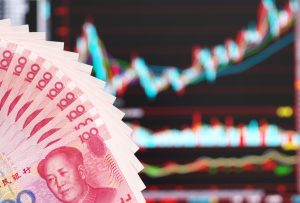Although the previous year has been extremely challenging for the Chinese economy, a more optimistic outlook appears to be returning as government data showed that factory activity throughout the country grew in June. Coupled with easing regulations surrounding tech stocks, China has managed to outperform other markets in staging a recovery.
Off the back of the news that factory activity had been growing, on June 30 the Shenzhen Component climbed more than 2 percent initially, before settling around the 1.57 percent mark to close at 12,896.2, whilst the Shenzhen Composite climbed 1.1 percent to 3,398.62.
The market movements come off the back of a relatively prosperous period as China’s strict zero-COVID policy — whereby regions can be placed into lockdown in the wake of small flare ups of COVID-19 cases — was eased in order for industries to reopen and bolster productivity.
Although markets have welcomed the return of industry, investors may be wary in the wake of news that the Chinese Communist Party may seek to keep the harsh measures in place for the next five years — meaning that any further flare ups of cases could heavily impact the economy.
As the data shows, China’s local stocks have enjoyed a relatively prosperous month in comparison to U.S. shares in recent months. Significantly, we can see the Shanghai Shenzhen CSI 300 Index holding strong in June following the easing of lockdown measures whilst the S&P 500 Index took a tumble.
While Chinese stocks rallied to their highest levels in three months, U.S. stocks struggled to come to terms with a 75-basis point rate hike imposed by the Federal Reserve in mid-June.
Despite the strong recovery, the situation in China remains volatile. Recent data has suggested that COVID-19 rates in China may be growing again, while investor concerns surrounding the prospect of a recession have been shown in volatile oil prices. As the financial downturn continues to take hold in Asia, traders have begun to bet on a drop in oil demand.
“There’s very clear evidence out there of economic stress being caused by the high prices, what some people refer to as demand destruction,” said Mike Muller, head of Asian crude trading firm, Vitol. It is “not just oil, but also liquefied natural gas,” he added.
One of the biggest impacts of China’s ongoing stock market troubles has been the country’s reassessment of its approach toward its technology sector.
Following a series of meetings in late May, China’s economic officials indicated that the worst of its tech stock crackdown may be in the past. The move offers the prospect of a recovery for the first time since late 2020, when many leading domestic tech firms like Alibaba, Tencent, Didi, and Meituan were impacted by the severe governmental regulatory enforcement.
It’s now hoped that the Chinese government will opt to ease the crackdown as a stimulus measure to counter the significant economic challenges that the country has faced throughout the past two years — as well as the closure of many industries in the wake of the recent COVID-19 outbreaks.
The news of the easing restrictions saw an influx of trading volume as investors saw the prospect of a rebound too tempting to ignore. Furthermore, policymakers in Beijing had been shown to be delivering on their promises from the first quarter of 2022 to support the economy and prevent a continued decline that had been threatened by troubles in the housing market as well as tech-firm restrictions.
“I think we are bumping along the bottom here,” Chi Lo, senior Asia Pacific investment strategist at BNP Paribas Asset Management, told Bloomberg. “When you look at the biggest drag on Chinese equities — which was the regulatory tightening on the tech sector — the worst is over.”
Significantly, the resurgence of Chinese tech stocks coupled with the easing of regulatory restrictions may pave the way for a blockbuster Ant Group listing that could have the potential to give China stocks both domestically and internationally a boost.
When Ant Group was initially looking to list in November 2020, the company would have held the world record for the biggest ever IPO. At the time, the financial services giant expected to generate $37 billion, leveraging a value of around $315 billion.
While times have changed since late 2020, the prospect of a major listing is very much needed for Chinese tech stocks.
Amid rumors that the regulatory easing could pave the way for an Ant listing, Alibaba’s U.S.-listed shares, which are more easily accessible for Western stock trading platforms alike, underwent wild price swings in recent months. Despite investors anticipating a major listing, China’s regulator is yet to state that any discussions on reviving the transaction are underway.
Although there are plenty of hurdles that can still present themselves in the coming months. China’s return to industry and regulatory easing has paved the way for a considerably more optimistic outlook for the Shenzhen Stock Exchange. Should COVID-19 cases remain low, we may see Chinese stocks recovering at a faster rate than many other markets around the world.

































